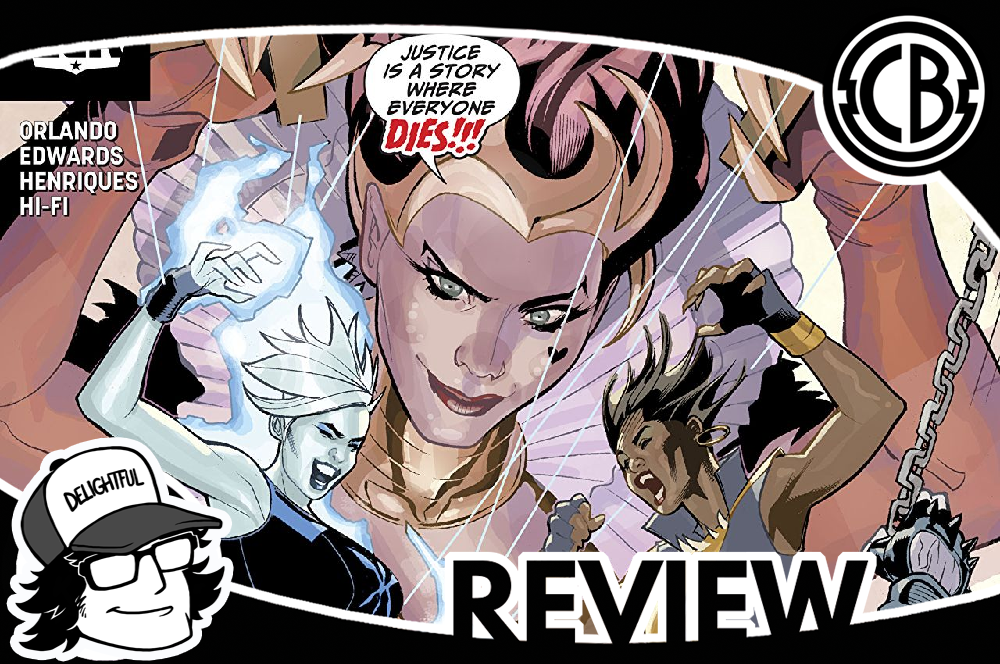Review: Justice League of America #22
By Jonathan Edwards
Huh. In a lot of ways, Justice League of America #22 is a pretty decent, even good, issue. And, that’s legitimately surprising. Steve Orlando’s entire JLA run has been building up to this story, but so much of it has been mediocre (or just plain bad) that it was hard to expect much good to come from “Deadly Fable.” Any yet, so far, it’s avoided a number of previously seen pitfalls. In place of the usually paper-thin and blatantly wrong antagonists, we get one with relatively sounds motivations and rationales behind her actions and statements. At least for a villain. Instead of ungrateful civilians who’re willing to turn against the JLA at the drop of a hat, we get citizens that’re concerned and horrified by their defeat. And, even the majority of the heroes react and respond appropriately to their given circumstances. Killer Frost is perhaps the major exception, but at the same time, her irrationality isn’t wholly without justification either. It’s not flawless, but it is a substantial step in the right direction.
We start with an expanded reiteration of the previous issue’s last three pages. In her dreams, Killer Frost sees the devastation of humankind that’s supposedly imminent if her hunger continues unabated. And, who is showing her this future but the Might Beyond the Mirror, who we quickly learn is actually Tsaritsa the Queen of Fables. The Queen then offers Caitlin a cure for her heat vampirism, and out of fear of hurting anyone else, she accepts. And, with that deal made, the Queen is finally able to manifest in their world. Now, maybe Caitlin should know better. After all, the JLA has been privy to the threat of the Might Beyond the Mirror for a good while. But, to be fair, it’s implied later in the issue that the Queen only reaches out to people when they’re at their most vulnerable, and that’s exactly what has happened here. After revealing that she’d given into her hunger, Caitlin wasn’t sure what her future would hold, especially with the JLA actively discussing if they should turn her into Amanda Waller of not. So, it’s not all that hard to sympathize with her error in judgment.
However, there’s a difference between sympathizing with someone and empathizing with them. The former is intellectually understanding what they’re going through, while the latter is actually feeling it. For Caitlin’s situation to become empathetic, a couple of things needed to be executed differently.
First and foremost, we really should have seen her struggle with the hunger in previous issues. Orlando kept telling us it was happening, but we never experienced that struggle for ourselves. We may have seen Caitlin looking for a cure and slipping up once or twice, but we haven’t been inside her head and dealing with the hunger alongside her since Justice League of America: Killer Frost Rebirth #1. And, by the end of that one-shot, it almost seemed like she’d conquered the hunger. If it’s still a daily struggle for her, we absolutely need to see that in action if we’re going to connect with her character.
The other big change regards Caitlin’s characterization in this issue. Namely, she takes way too long to realize that the Queen isn’t going to make good on her promise to be a benevolent ruler. Realistically, that should’ve occurred to Caitlin the instant the Queen started fighting the JLA. Instead, that’s only when she starts to think something’s up. It doesn’t fully click until the end of the issue, and that just makes it seem like Caitlin’s way more out of her head than intended. I mean, yeah, denial is a thing, but this borders on delirium at times.
In addition to sharing my surname, Neil Edwards’s art is pretty good overall. There’s a couple of moments where character expressions fall short in conveying the big emotion they’re going for, but there are plenty more instances where they do succeed. I will admit that it took me a good while to realize that Xenos had been with the JLA for the whole issue, but I’m more inclined to believe that’s because the story never draws any specific attention to him rather than due to any real failures of the art.
The big concern I have going forward with Justice League of America is not being sure whether this issue is indicative of a new direction for the book or just a fluke. With so much buildup, you’d expect “Deadly Fable” to be a big, five or six-part story, but the next issue is apparently the conclusion. What’s more, the main thing that’s made Queen of Fables a refreshing villain here is that it feels like she’s either lying about wanting to be a benevolent ruler or “benevolent” to her means tyrannical to everyone else. But, I’m not quite convinced that’s what Orlando is going for, when all of this book’s previous villains have on been no more than skin-deep. Lord Havok was oppressive because he believed people needed to be oppressed to survive. And, Aron Aut wanted to accelerate the destruction of the Microverse because he believed that the state of nothingness was perfection. So, I worry that when Queen of Fables says she intends to be a benevolent ruler, she means it. Because then it becomes a matter of the JLA deposing someone just for the sake of people not being ruled without any critical inspection on if that rule is actually beneficial. And, there is a little bit of evidence to support that concern with Vixen’s line “monarchs don’t do well here.” But, that could easily be overthinking it, and perhaps that’s not worth worrying about unless it really does happen next issue. So, for now, it’s probably worth entertaining the possibility that this book is finally getting better.
Score: 3/5
Justice League of America #22
DC Comics


